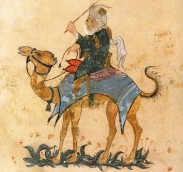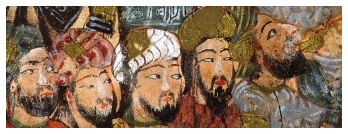|
| Maqamat Al-Hariri Illustrated Arabic Manuscript from the 13th century |
 |
|
|
| One of the greatest Arabic illuminated manuscripts of all time—a compendium of tales by al-Hariri (1054-1122) illustrated by Yahya ibn Mahmud al-Wasiti. | Paris, Bibl. Nat., ms. arabe 5847 deluxe facsimile edition with introduction by Oleg Grabar |
|
|
|  |
|
| Al-Maqamat is the title of a book written by Abu Muhammad al Qasim ibn Ali al-Hariri (1054-1122) containing fifty relatively short stories (maquamat = "settings" or "sessions"), each one identified by the name of a city in the Muslim world of the time. The stories tell of actual adventures and especially the verbal pronouncements in verse or in prose of a roguish and peripatetic hero, Abu Zayd from Saruj, a town in northern Syria, as told by al-Harith, a sober and slightly gullible merchant travelling from place to place. Double and triple puns, unusual meanings of words and elaborate grammatical constructions are used to exhibit the astounding and sophisticated wealth of the Arabic language. The genre of the maqamat became an almost instant success because of the extraordinary quality of its writing. Dozens of manuscripts of Hariri's Maqamat have been preserved from his own time, including a probable autograph, and hundreds have remained from the thirteenth and later centuries. Nearly all of them were copied in the core areas of the Arabic-speaking world—Egypt, Syria, Iraq—where there lived and prospered the class of educated Arabs likely to enjoy reading this forbidding book and interested in acquiring, perhaps even in sponsoring, a luxury edition of a beloved work. Even though the text itself and the reasons for its success are hardly topics for illustrations, thirteen of these manuscripts are known to have been provided with images inspired by narrative episodes from individual stories. Of these, six are from the thirteenth century, five are from the fourteenth, one is probably from the sixteenth or seventeenth century, and one is dated in the early eighteenth, even though one of its miniatures appears to be much earlier. Of all the manuscripts with pictures containing al-Hariri's great work, Paris BN ms. arabe 5847 towers above all others for the quality and variety of its illustrations. It was completed in C.E. 1237 (A.H. 634, in the month of ramadan) and, according to its colophon, was copied and illustrated by the same individual, Yahya ibn Mahmud ibn Yahya ibn Abi al-Hasan ibn Kuwwarih al-Wasiti, presumably originating from the city of al-Wasit. The manuscript survives with 99 miniatures. From the time they were first made known, in large surveys of the late nineteenth century, the miniatures from this manuscript were praised for their realism in depicting life. | Nearly every book on any aspect of Islamic, and especially Arab, history or culture uses these images to illustrate almost all topics except for military matters. Some of them, the village or the drove of camels, have even found many more uses than is legitimate to propose for them; in fact one can hardly look at the book of traditional Islamic or Arab culture, history, or society that does not illustrate its points with images from the Maqamat, even if they are not appropriate with respect to time or place. The subjects of the images are many, but also consistent and one does not need, at least at first glance, the text to understand the activities depicted and to agree that they provide a sort of panorama of the actual episodes of a human life from birth to death, or else the activities of an ordinary Arab urban middle class world, spinning, going to the mosque, suing someone in front of a judge, travelling, drinking in a tavern, going to the library, sleeping, eating, buying a slave. The people involved in many of these activities may be slightly caricaturied, but with humour and sympathy, and their facial types, clothes, poses, or gestures can all be assumed to reflect observations made by the artist from the surrounding world. It is easy to imagine al-Wasiti walking around his city making sketches of the people he sees or, perhaps more likely, storing in his memory hundreds of pictures of daily life, including details of poses or of the ways in which clothes cling to a person. He did not observe the vegetation in the same way and his plants, even the trees he utilizes so artfully, remain stereotyped and primarily ornamental. In short, it is reasonable to define the art of al-Wasiti as one of realism of intent. He wanted his viewers to see and recognize a specific world and to be amused by it, but he did not feel compelled to depict every detail of every feature. (adapted from Oleg Grabar's text) The facsimile: Full color reproduction in the original format (27 x 38 cm), 334 pp, with 99 illustrations. Scholarly commentary (44, xxii, 38 pp) by Oleg Grabar, Prof. of Islamic Art, Institute for Advanced Study, Princeton, New Jersey. Published by Touchart, London, 2003. (Please call for special OMI price) |
|
 |
OMI - Old Manuscripts & Incunabula PO Box 6019 FDR Station, New York NY 10150
tel/fax 212/ 758-1946 - http://www.omifacsimiles.com - immels@earthlink.net